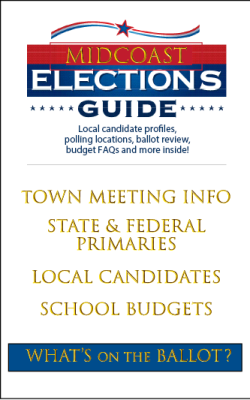Letter to the editor: Ranked Choice voting, what’s in it for you?
If you believe in voting your conscience, majority rule and civility in politics, Ranked Choice Voting (RCV), Question 5 on this November’s Ballot , may be the answer.
What it does:
Conscience voting replaces strategic voting. — Do you currently vote strategically, voting for a less-than-ideal candidate to prevent someone you strongly disagree with from winning? With RCV you can vote for your favorite candidate, and your vote will not be discarded if your candidate is unsuccessful. Your second choice will get your vote instead.
Majority rule is restored. — Are you tired of winners not representing the majority of the electorate? With RCV, the winner will represent the majority of the electorate because he/she will represent the preference, by rank, of the greatest number of voters.
Civility is rewarded. — Do you despair at polarization, hyperbole and special interest peddling in politics? Under RCV, candidates will no longer be able to pander to their base, ignore the views of the rest of the voters, and insult other candidates and constituencies if they hope to be anyone’s second choice. Portland, Maine, Mayor Mike Brennan explained, “In other [non-RCV] campaigns, if somebody had a lawn sign of your opponent on the lawn, you walked by. In this case, you stopped and still talked to them.”
What it doesn’t do: Ranked choice voting does not favor any party. However, the ability of citizens to vote their conscience, rather than strategically, may improve the chances of independent and third party candidates, opening up our political system.
How it works: This system affects races with more than two candidates. The ballot lists candidates’ names followed by columns representing choice rankings (first, second, third, etc.). Voters start with the “first choice” column and fill in the dot next to their first choice. Then they move over to the second choice column and put a dot next to their second choice, and so on.
The ballots are simple and easy to use. In the 2011 Portland, Maine, mayoral contest there were 15 candidates on the ballot. Yet 94% of Portland voters said they fully understood the ballot design and voting instructions. Facts back this up: 99.83% of the ballots were valid (i.e. unspoiled).
When the ballots are tallied, if no candidate has more than 50% of the vote, ballots for the candidate who has the least votes are divided among the higher ranked candidates according to the second choices on the losing candidate’s ballots. If no candidate has yet garnered 50% of the vote, this process repeats itself until there is a clear majority winner.
This system functions similarly to a runoff election between the top two candidates, but with much less hassle and expense. There is no need to stage a second election.
Is it legal? Yes. Courts have found ranked choice voting to be constitutional. The principle of “one person, one vote” is preserved.
The History of RCV: While not widely used, RCV is hardly new. It was advocated in 19th-century England by Thomas Hare, who developed the concept of the Single Transferable Vote. In the early 20th century, numerous U.S. cities adopted RCV to reform municipal elections. This change led to greater diversity in elected officials. The system worked.
The established party machines, angered by their diminished power, pushed back against RCV. They began mounting legal challenges and placing repeal efforts on ballots. These efforts gained traction as fears of racial diversity and communism heightened in the middle of the 20th century. By 1960, Cambridge, MA, was the only remaining U.S. city with RCV.
Currently, RCV is being used in a scattering of U.S. municipalities, but nowhere in the U.S. is it used for state-level elections.
Maine Votes: In nine of the past eleven Maine gubernatorial races, no candidate garnered 50% of the vote. In five, the governor was elected by less than 40%. Maine has not elected a first-term governor by a majority since 1966.
Seeing that majority rule and voter confidence needed to be restored, the non-partisan League of Women Voters of Maine took action in 2011, endorsing RCV. They convened a working group of civic leaders and legal scholars to draft the language for a RCV citizen initiative bill. The Committee for Ranked Choice Voting formed in 2014 and gathered the signatures necessary to get the initiative on the 2016 ballot as a referendum question.
This November, Maine votes on whether to become the first state in the nation to use RCV statewide. If the referendum is successful, Maine will elect its U.S. Senators and Congressional Representatives, its Governor, and its State Senators and Representatives by RCV, which will also apply to all primaries for these offices.
Meg Barclay lives in Camden






























